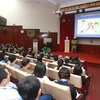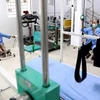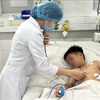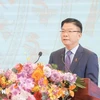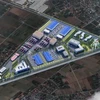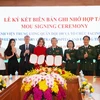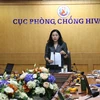As many as 11 organisations and enterprises, which participated in the implementation of a campaign to support breastfeeding in the workplace, were honoured at a conference in Ho Chi Minh City on July 10.
Hosted by the Vietnam General Confederation of Labour (VGCL) , the Vietnam Chamber of Commerce and Industry (VCCI) and the Alive & Thrive project (A&T), the conference was part of Vietnam’s Breastfeeding Week 2015.
Businesses participating in the conference pledged to engage with the programme in the future.
Initiated in 2012 and funded by the VGCL and A&T, the programme to support breastfeeding in the workplace was carried out in 70 organisations, including 10 State agencies and 60 enterprises, where 70 breastfeeding rooms were set up to support mothers at work.
VGCL Vice President Nguyen Thi Thu Hong said her agency had worked closely and effectively with A&T to implement the programme, together with VCCI.
The programme’s success, along with the State’s new policy on increasing maternity leave from 4 to 6 months, created favourable conditions for VGCL to expand the programme, Hong stressed.
A&T representative Nemat Hajeebhoy underscored the need to set up breastfeeding rooms in the workplace, benefitting female employees and their children.
She expressed her hope that more than 200 breastfeeding rooms would be established in enterprises across the country during this year’s Breastfeeding Week.
The General Statistics Office announced in 2014 that women accounted for 48 percent of the total workforce in Vietnam.
According to the National Institute of Nutrition, only 19.6 percent of Vietnamese children were breastfed for the first six months of their lives in 2010. Meanwhile, in recent years there has been a increase in the number of children bottle-fed during the first six months of their lives.-VNA
Hosted by the Vietnam General Confederation of Labour (VGCL) , the Vietnam Chamber of Commerce and Industry (VCCI) and the Alive & Thrive project (A&T), the conference was part of Vietnam’s Breastfeeding Week 2015.
Businesses participating in the conference pledged to engage with the programme in the future.
Initiated in 2012 and funded by the VGCL and A&T, the programme to support breastfeeding in the workplace was carried out in 70 organisations, including 10 State agencies and 60 enterprises, where 70 breastfeeding rooms were set up to support mothers at work.
VGCL Vice President Nguyen Thi Thu Hong said her agency had worked closely and effectively with A&T to implement the programme, together with VCCI.
The programme’s success, along with the State’s new policy on increasing maternity leave from 4 to 6 months, created favourable conditions for VGCL to expand the programme, Hong stressed.
A&T representative Nemat Hajeebhoy underscored the need to set up breastfeeding rooms in the workplace, benefitting female employees and their children.
She expressed her hope that more than 200 breastfeeding rooms would be established in enterprises across the country during this year’s Breastfeeding Week.
The General Statistics Office announced in 2014 that women accounted for 48 percent of the total workforce in Vietnam.
According to the National Institute of Nutrition, only 19.6 percent of Vietnamese children were breastfed for the first six months of their lives in 2010. Meanwhile, in recent years there has been a increase in the number of children bottle-fed during the first six months of their lives.-VNA





